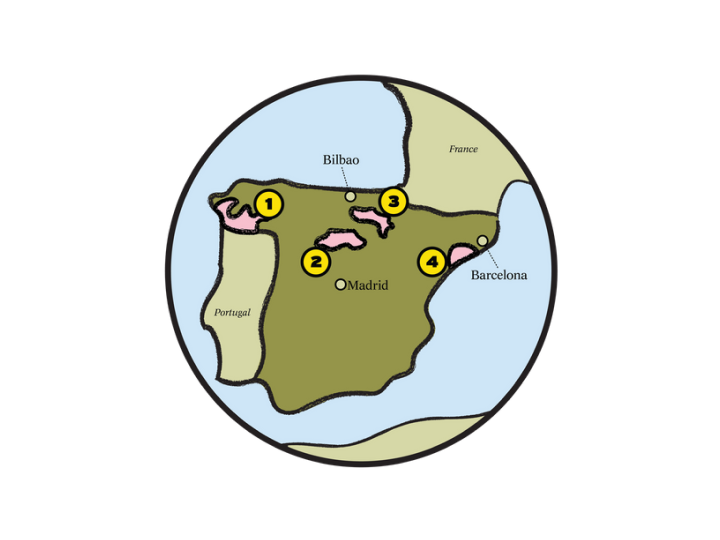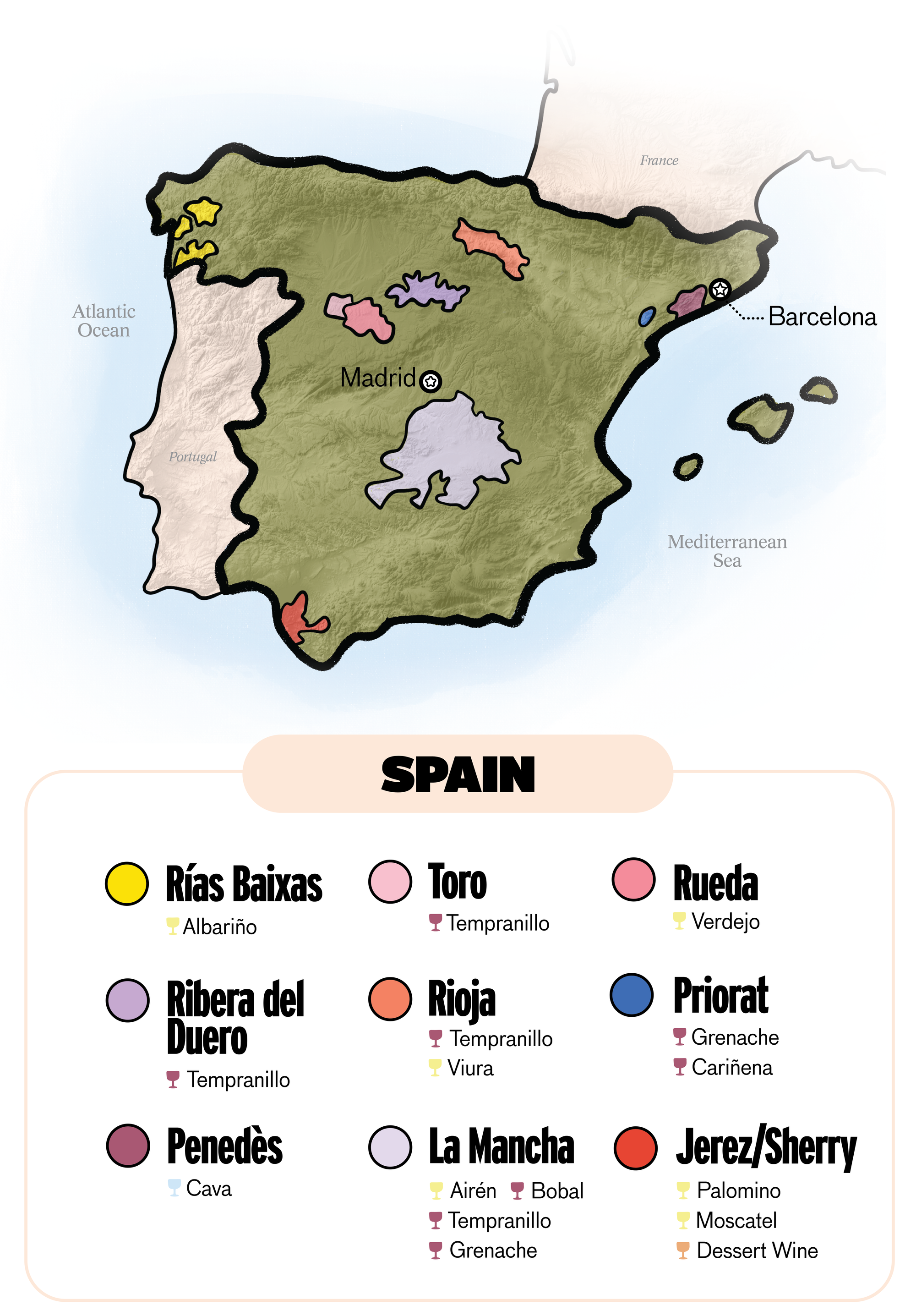

Home of everyone's second favourite grape variety, Tempranillo, as well as so much more.
History--red
Spain is part of the 'Big 4' European wine regions (France, Italy & Germany make up the rest), and has a loooong wine history going back over 3000 years.

From the Phoenicians to the Romans to the Middle Ages, wine has been a big part of the Spanish culture and lifestyle and remains so to this day.
In the 19th century, the vine louse phylloxera began to destroy all of the vines in Northern Europe. Winemakers from France came across the Pyrenees mountain range and brought new grape varieties and modern techniques.

By the time phylloxera reached Spain, the discovery that American vine rootstock was immune and could be grafted onto European vines resulted in less damage to Spanish vineyards.
War took a heavy toll on Spain in the early 1900s, but agronomists and winemakers worked hard to pull the quality of wine steadily upwards. Today, a new generation of winemakers have quietly begun crafting spectacular wines and experimenting with varietals that would have been unthinkable only a short time ago. Wine remains an important commodity and an integral part of Spanish culture.
Main regions--aromatic

Rías Baixas - A coastal region in the northwestern corner, this is where the great grape Albariño plants its feet. The rivers of the region, the sandy soils and the ocean influence combine to give wines of great freshness and vigour.

Toro - This little region makes some seriously BIG wines! In fact, they are known best for their full-bodied and powerful reds made from Tempranillo (which they locally call Tinta da Toro.) Expect high tannins, weighty alcohol levels, and inky density in the glass.
Rueda - Located in the northern central part of the country, Rueda is famous for its white wines made from Verdejo. This indigenous white grape performs particularly well in the dry, continental climate of the region.
Ribera del Duero - Another Tempranillo region, this time offering black fruits as well as plenty of muscle. Powerful styles that tend towards the modern end of the spectrum.
Rioja - The most famous Spanish wine region! Sitting in the central north of Spain, this is ground zero for Tempranillo. Oak is highly prized here, with the most expensive wines spending many years resting in barrels before being released. Lots of red fruit and spice from these wines. They also make age-worthy white wines with the local grape Viura.

Priorat - This is one of Spain's most highly-prized regions - and the price tag of most bottles from this region tell the same story! The best wines from this region are dry reds based on Grenache as a single varietal or blended with Carignan (which they call Cariñena). These wines are well known for having concentrated and highly intense flavours thanks to the low-yielding old vines found in the region.
Penedès - A relatively small region, but so important. Located on the outskirts of Barcelona, Penedès is home to the majority of the Cava producers in Spain. Gently undulating hills grow a mix of grapes that go into this emblematic Spanish sparkling wine.
La Mancha - Situated just outside the hustle and bustle of Madrid, La Mancha is just as much a part of the action! In fact, not only is it the largest wine region in Spain, but it's also the largest continuous vine-growing area in the world! Most of the wines produced here provide great value and are meant for early consumption.
Jerez/Sherry - You already learned that grapevines first came to Spain more than 3,000 years ago, but did you know that the first plantings were in Jerez-Sherry? Talk about an OG! This region is also the hottest part of the country. Fortified wines — both dry and sweet — are the legacy of the land, and the neutral white Palomino grape dominates most of the production.
Main grapes--racy
Tempranillo (aka Tinta Roriz) - a rich, spicy, dense red that thrives in the warmer climates of central Spain. In Rioja, it spends considerable time in oak barrels to further complex its earthy, spicy aromas. Not to mention a go-to pairing with Paella!

Grenache (aka Garnatxa or Garnacha) - fruit-forward and peppery, with serious heat. Although lighter in frame than Tempranillo, most of the Spanish expressions are still powerful and need a few years in bottle to show their best. The small and iconic region of Priorat produces some of the highest quality examples in the country!
Airén - the most planted white grape variety in the world! But believe it or not, is rarely seen outside of Spain, and is most commonly found basking in the sun in the La Mancha region. It is relatively high in acidity and produces easygoing, light whites for summertime drinking. Not exactly the same, but close to Pinot Grigio perhaps?
Albariño - the zingy, fresh white found in the north-western region of Rias Baixas, Albariño has made many friends worldwide with its zippy edge and citrusy fruit profile.
Specific wine styles--aromatic
Red Rioja- oaky, spicy and powerful wines based on Tempranillo! These age-worthy reds are a nation wine icon with fans that span across the globe.
Sherry - the fortified wines of Jerez in the south of the country are known around the world. Salty, fresh and intense. Sometimes bone dry, but more often sweet!
Cava - Cava is to Spain as Champagne is to France. A national treasure, made from local varieties Xarel-lo, Macabeo and Parellada.

About the Author & Artist
Alex Tanner is a certified sommelier that spends more time running in old-growth forests than any other somm. If 'nature-loving hippy' were a certification, she'd have done that too. A talented illustrator with a unique style, her doodling works are inspired by the world of wine - and somehow, seem to improve after a glass or two.
Do you know your wine personality? If your answer is no, take our quiz to find out which wines to pick up next and build your box!
Build my box





